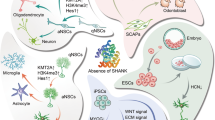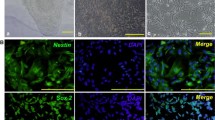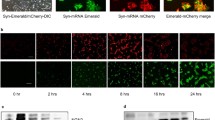Abstract
Stem cells have become a major focus of scientific interest as a potential source of somatic cell types for biomedical applications. Understanding and controlling the elicitors and mechanisms in differentiation of pluripotent stem cell-derived somatic cell types remains a key challenge. The major types of molecular processes that control cellular differentiation involve evolutionary conserved cell signaling pathways. Notch receptors participate in a wide variety of biological processes, including cell fate decisions of stem cells. This study explores the potential of protein transduction to directly deliver recombinant Notch-1 intracellular domain (NICD) into mammalian cells in order to accomplish transgene-free Notch activation. We engineered a cell-permeant version of NICD and explored its function on mouse and human neural stem cells. We show that NICD transduction modulates known direct and indirect Notch target genes and antagonizes the DAPT-mediated inhibition of Notch signaling on the transcriptional level. Moreover, NICD enhances cell proliferation accompanied by increased cyclin D1 and decreased p27 protein levels. In the absence of growth factors NICD strongly impairs neuronal differentiation while being insufficient to keep cells in a proliferative state. Furthermore, our studies depict NICD protein transduction as a novel tool for a time and dose-dependent non-genetic modulation of Notch signaling to decipher its cellular functions.





Similar content being viewed by others
References
Artavanis-Tsakonas, S., Rand, M. D., & Lake, R. J. (1999). Notch signaling: cell fate control and signal integration in development. Science, 284, 770–776.
Louvi, A., & Artavanis-Tsakonas, S. (2006). Notch signalling in vertebrate neural development. Nature Reviews Neuroscience, 7, 93–102.
Aster, J. C., Robertson, E. S., Hasserjian, R. P., Turner, J. R., Kieff, E., & Sklar, J. (1997). Oncogenic forms of NOTCH1 lacking either the primary binding site for RBP-Jkappa or nuclear localization sequences retain the ability to associate with RBP-Jkappa and activate transcription. The Journal of Biological Chemistry, 272, 11336–11343.
Tamura, K., Taniguchi, Y., Minoguchi, S., et al. (1995). Physical interaction between a novel domain of the receptor Notch and the transcription factor RBP-J kappa/Su(H). Current Biology, 5, 1416–1423.
Jarriault, S., Brou, C., Logeat, F., Schroeter, E. H., Kopan, R., & Israel, A. (1995). Signalling downstream of activated mammalian Notch. Nature, 377, 355–358.
Tani, S., Kurooka, H., Aoki, T., Hashimoto, N., & Honjo, T. (2001). The N- and C-terminal regions of RBP-J interact with the ankyrin repeats of Notch1 RAMIC to activate transcription. Nucleic Acids Research, 29, 1373–1380.
Barrick, D., & Kopan, R. (2006). The Notch transcription activation complex makes its move. Cell, 124, 883–885.
Kurooka, H., Kuroda, K., & Honjo, T. (1998). Roles of the ankyrin repeats and C-terminal region of the mouse notch1 intracellular region. Nucleic Acids Research, 26, 5448–5455.
Kopan, R., Nye, J. S., & Weintraub, H. (1994). The intracellular domain of mouse Notch: a constitutively activated repressor of myogenesis directed at the basic helix-loop-helix region of MyoD. Development, 120, 2385–2396.
Yoon, K., & Gaiano, N. (2005). Notch signaling in the mammalian central nervous system: insights from mouse mutants. Nature Neuroscience, 8, 709–715.
Kageyama, R., Ohtsuka, T., Hatakeyama, J., & Ohsawa, R. (2005). Roles of bHLH genes in neural stem cell differentiation. Experimental Cell Research, 306, 343–348.
Mumm, J. S., & Kopan, R. (2000). Notch signaling: from the outside in. Developmental Biology, 228, 151–165.
Dreesen, O., & Brivanlou, A. H. (2007). Signaling pathways in cancer and embryonic stem cells. Stem Cell Reviews, 3, 7–17.
Campos, L. S., Decker, L., Taylor, V., & Skarnes, W. (2006). Notch, epidermal growth factor receptor, and beta1-integrin pathways are coordinated in neural stem cells. The Journal of Biological Chemistry, 281, 5300–5309.
Surmacz, B., Noisa, P., Risner-Janiczek, J. R., et al. DLK1 promotes neurogenesis of human and mouse pluripotent stem cell-derived neural progenitors via modulating notch and BMP signalling. Stem Cell Reviews. doi:10.1007/s12015-011-9298-7.
Ables, J. L., Breunig, J. J., Eisch, A. J., & Rakic, P. Not (ch) just development: Notch signalling in the adult brain. Nature Reviews Neuroscience, 12, 269–283.
Hurlbut, G. D., Kankel, M. W., Lake, R. J., & Artavanis-Tsakonas, S. (2007). Crossing paths with Notch in the hyper-network. Current Opinion in Cell Biology, 19, 166–175.
Sanalkumar, R., Dhanesh, S. B., & James, J. (2010). Non-canonical activation of Notch signaling/target genes in vertebrates. Cellular and Molecular Life Sciences, 67, 2957–2968.
Das, D., Lanner, F., Main, H., et al. (2010). Notch induces cyclin-D1-dependent proliferation during a specific temporal window of neural differentiation in ES cells. Developmental Biology, 348, 153–166.
Borghese, L., Dolezalova, D., Opitz, T., et al. (2010). Inhibition of notch signaling in human embryonic stem cell-derived neural stem cells delays G1/S phase transition and accelerates neuronal differentiation in vitro and in vivo. Stem Cells, 28, 955–964.
Androutsellis-Theotokis, A., Leker, R. R., Soldner, F., et al. (2006). Notch signalling regulates stem cell numbers in vitro and in vivo. Nature, 442, 823–826.
Shimizu, K., Chiba, S., Saito, T., et al. (2002). Integrity of intracellular domain of Notch ligand is indispensable for cleavage required for release of the Notch2 intracellular domain. EMBO Journal, 21, 294–302.
Hicks, C., Ladi, E., Lindsell, C., et al. (2002). A secreted Delta1-Fc fusion protein functions both as an activator and inhibitor of Notch1 signaling. Journal of Neuroscience Research, 68, 655–667.
Schmidt, M. H., Bicker, F., Nikolic, I., et al. (2009). Epidermal growth factor-like domain 7 (EGFL7) modulates Notch signalling and affects neural stem cell renewal. Nature Cell Biology, 11, 873–880.
Deregowski, V., Gazzerro, E., Priest, L., Rydziel, S., & Canalis, E. (2006). Notch 1 overexpression inhibits osteoblastogenesis by suppressing Wnt/beta-catenin but not bone morphogenetic protein signaling. The Journal of Biological Chemistry, 281, 6203–6210.
Munst, B., Patsch, C., & Edenhofer, F. (2009). Engineering cell-permeable protein. Journal of Visualized Experiments, 28(34). doi:10.3791/1627.
Derossi, D., Chassaing, G., & Prochiantz, A. (1998). Trojan peptides: the penetratin system for intracellular delivery. Trends in Cell Biology, 8, 84–87.
Schwarze, S. R., & Dowdy, S. F. (2000). In vivo protein transduction: intracellular delivery of biologically active proteins, compounds and DNA. Trends in Pharmacological Sciences, 21, 45–48.
Edenhofer, F. (2008). Protein transduction revisited: novel insights into the mechanism underlying intracellular delivery of proteins. Current Pharmaceutical Design, 14, 3628–3636.
Vives, E., Brodin, P., & Lebleu, B. (1997). A truncated HIV-1 Tat protein basic domain rapidly translocates through the plasma membrane and accumulates in the cell nucleus. The Journal of Biological Chemistry, 272, 16010–16017.
Schwarze, S. R., Ho, A., Vocero-Akbani, A., & Dowdy, S. F. (1999). In vivo protein transduction: delivery of a biologically active protein into the mouse. Science, 285, 1569–1572.
Nagahara, H., Vocero-Akbani, A. M., Snyder, E. L., et al. (1998). Transduction of full-length TAT fusion proteins into mammalian cells: TAT-p27Kip1 induces cell migration. Nature Medicine, 4, 1449–1452.
Nolden, L., Edenhofer, F., Haupt, S., et al. (2006). Site-specific recombination in human embryonic stem cells induced by cell-permeant Cre recombinase. Nature Methods, 3, 461–467.
Gump, J. M., June, R. K., & Dowdy, S. F. (2010). Revised role of glycosaminoglycans in TAT protein transduction domain-mediated cellular transduction. The Journal of Biological Chemistry, 285, 1500–1507.
Derossi, D., Joliot, A. H., Chassaing, G., & Prochiantz, A. (1994). The third helix of the Antennapedia homeodomain translocates through biological membranes. The Journal of Biological Chemistry, 269, 10444–10450.
Patsch, C., Peitz, M., Otte, D. M., et al. (2010). Engineering cell-permeant FLP recombinase for tightly controlled inducible and reversible overexpression in embryonic stem cells. Stem Cells, 28, 894–902.
Thier, M., Munst, B., & Edenhofer, F. (2010). Exploring refined conditions for reprogramming cells by recombinant Oct4 protein. International Journal of Development Biology, 54, 1713–1721.
Seifinejad, A., Tabebordbar, M., Baharvand, H., Boyer, L. A., & Salekdeh, G. H. (2010). Progress and promise towards safe induced pluripotent stem cells for therapy. Stem Cell Reviews, 6, 297–306.
Said Hassane, F., Saleh, A. F., Abes, R., Gait, M. J., & Lebleu, B. (2010). Cell penetrating peptides: overview and applications to the delivery of oligonucleotides. Cellular and Molecular Life Sciences, 67, 715–726.
Tunnemann, G., Martin, R. M., Haupt, S., Patsch, C., Edenhofer, F., & Cardoso, M. C. (2006). Cargo-dependent mode of uptake and bioavailability of TAT-containing proteins and peptides in living cells. The FASEB Journal, 20, 1775–1784.
Haupt, S., Edenhofer, F., Peitz, M., Leinhaas, A., & Brustle, O. (2007). Stage-specific conditional mutagenesis in mouse embryonic stem cell-derived neural cells and postmitotic neurons by direct delivery of biologically active Cre recombinase. Stem Cells, 25, 181–188.
Bosnali, M., & Edenhofer, F. (2008). Generation of transducible versions of transcription factors Oct4 and Sox2. Biological Chemistry, 389, 851–861.
Brustle, O., Jones, K. N., Learish, R. D., et al. (1999). Embryonic stem cell-derived glial precursors: a source of myelinating transplants. Science, 285, 754–756.
Novak, A., Guo, C., Yang, W., Nagy, A., & Lobe, C. G. (2000). Z/EG, a double reporter mouse line that expresses enhanced green fluorescent protein upon Cre-mediated excision. Genesis, 28, 147–155.
Okabe, S., Forsberg-Nilsson, K., Spiro, A. C., Segal, M., & McKay, R. D. (1996). Development of neuronal precursor cells and functional postmitotic neurons from embryonic stem cells in vitro. Mechanisms of Development, 59, 89–102.
Conti, L., Pollard, S. M., Gorba, T., et al. (2005). Niche-independent symmetrical self-renewal of a mammalian tissue stem cell. PLoS Biology, 3, e283.
Koch, P., Opitz, T., Steinbeck, J. A., Ladewig, J., & Brustle, O. (2009). A rosette-type, self-renewing human ES cell-derived neural stem cell with potential for in vitro instruction and synaptic integration. Proceedings of the National Academy of Sciences of the United States of America, 106, 3225–3230.
Jeffries, S., & Capobianco, A. J. (2000). Neoplastic transformation by Notch requires nuclear localization. Molecular and Cellular Biology, 20, 3928–3941.
Sarmento, L. M., Huang, H., Limon, A., et al. (2005). Notch1 modulates timing of G1-S progression by inducing SKP2 transcription and p27 Kip1 degradation. The Journal of Experimental Medicine, 202, 157–168.
Hitoshi, S., Alexson, T., Tropepe, V., et al. (2002). Notch pathway molecules are essential for the maintenance, but not the generation, of mammalian neural stem cells. Genes & Development, 16, 846–858.
Nagao, M., Sugimori, M., & Nakafuku, M. (2007). Cross talk between notch and growth factor/cytokine signaling pathways in neural stem cells. Molecular and Cellular Biology, 27, 3982–3994.
Hitoshi, S., Seaberg, R. M., Koscik, C., et al. (2004). Primitive neural stem cells from the mammalian epiblast differentiate to definitive neural stem cells under the control of Notch signaling. Genes & Development, 18, 1806–1811.
Kopan, R., & Ilagan, M. X. (2009). The canonical Notch signaling pathway: unfolding the activation mechanism. Cell, 137, 216–233.
Guentchev, M., & McKay, R. D. (2006). Notch controls proliferation and differentiation of stem cells in a dose-dependent manner. European Journal of Neuroscience, 23, 2289–2296.
Dohda, T., Maljukova, A., Liu, L., et al. (2007). Notch signaling induces SKP2 expression and promotes reduction of p27Kip1 in T-cell acute lymphoblastic leukemia cell lines. Experimental Cell Research, 313, 3141–3152.
Murata, K., Hattori, M., Hirai, N., et al. (2005). Hes1 directly controls cell proliferation through the transcriptional repression of p27Kip1. Molecular and Cellular Biology, 25, 4262–4271.
Campa, V. M., Gutierrez-Lanza, R., Cerignoli, F., et al. (2008). Notch activates cell cycle reentry and progression in quiescent cardiomyocytes. The Journal of Cell Biology, 183, 129–141.
Ronchini, C., & Capobianco, A. J. (2001). Induction of cyclin D1 transcription and CDK2 activity by Notch(ic): implication for cell cycle disruption in transformation by Notch(ic). Molecular and Cellular Biology, 21, 5925–5934.
Oishi, K., Kamakura, S., Isazawa, Y., et al. (2004). Notch promotes survival of neural precursor cells via mechanisms distinct from those regulating neurogenesis. Developmental Biology, 276, 172–184.
Nguyen, L., Besson, A., Heng, J. I., et al. (2006). p27kip1 independently promotes neuronal differentiation and migration in the cerebral cortex. Genes & Development, 20, 1511–1524.
Carruthers, S., Mason, J., & Papalopulu, N. (2003). Depletion of the cell-cycle inhibitor p27(Xic1) impairs neuronal differentiation and increases the number of ElrC(+) progenitor cells in Xenopus tropicalis. Mechanisms of Development, 120, 607–616.
Vernon, A. E., Movassagh, M., Horan, I., Wise, H., Ohnuma, S., & Philpott, A. (2006). Notch targets the Cdk inhibitor Xic1 to regulate differentiation but not the cell cycle in neurons. EMBO Reports, 7, 643–648.
Aguirre, A., Rubio, M. E., & Gallo, V. (2010). Notch and EGFR pathway interaction regulates neural stem cell number and self-renewal. Nature, 467, 323–327.
Faux, C. H., Turnley, A. M., Epa, R., Cappai, R., & Bartlett, P. F. (2001). Interactions between fibroblast growth factors and Notch regulate neuronal differentiation. Journal of Neuroscience, 21, 5587–5596.
Stock, K., Nolden, L., Edenhofer, F., Quandel, T., & Brustle, O. (2010). Transcription factor-based modulation of neural stem cell differentiation using direct protein transduction. Cellular and Molecular Life Sciences, 67, 2439–2449.
Zhang, Y. E., Wang, J. N., Tang, J. M., et al. (2009). In vivo protein transduction: delivery of PEP-1-SOD1 fusion protein into myocardium efficiently protects against ischemic insult. Molecules and Cells, 27, 159–166.
Acknowledgements
We thank Joseph Itskovitz-Eldor, Stem Cell Center, Technion - Israel Institute of Technology, Haifa, Israel, for providing the hES cells. We thank Dr. Sally Lowell for providing the cDNA of murine Notch1-ICD. In addition, we thank the lab of Prof. Dr. Austin Smith for providing NS5 cells and Dr. Phillip Koch for providing lt-NES®. This work was supported by the Deutsche Forschungsgemeinschaft (DFG, ED 79/2), the German Ministry of Research and Technology (BMBF, ‘NewNeurons’, 01GN1009B), the EU (LSHG-CT-2006-018739, ESTOOLS) and the Hertie Foundation.
Conflict of Interest
The authors declare no potential conflict of interest.
Author information
Authors and Affiliations
Corresponding author
Electronic supplementary material
Below is the link to the electronic supplementary material.
Supplementary Figure
(JPEG 662 kb)
Supplementary Table
(JPEG 675 kb)
Rights and permissions
About this article
Cite this article
Haupt, S., Borghese, L., Brüstle, O. et al. Non-Genetic Modulation of Notch Activity by Artificial Delivery of Notch Intracellular Domain into Neural Stem Cells. Stem Cell Rev and Rep 8, 672–684 (2012). https://doi.org/10.1007/s12015-011-9335-6
Published:
Issue Date:
DOI: https://doi.org/10.1007/s12015-011-9335-6




